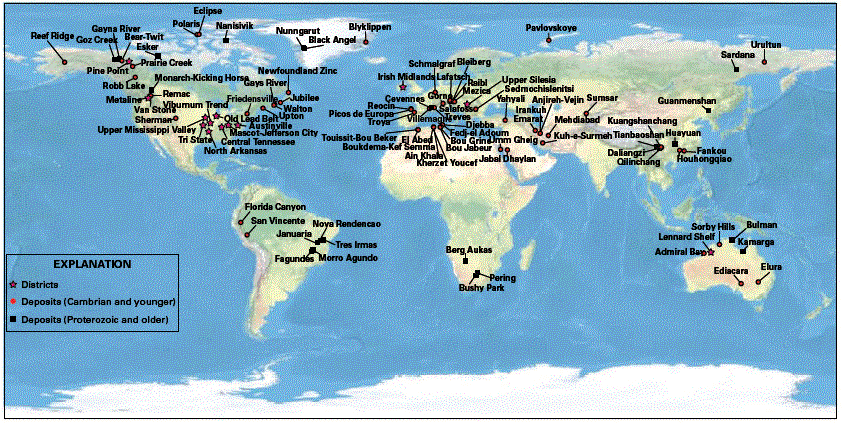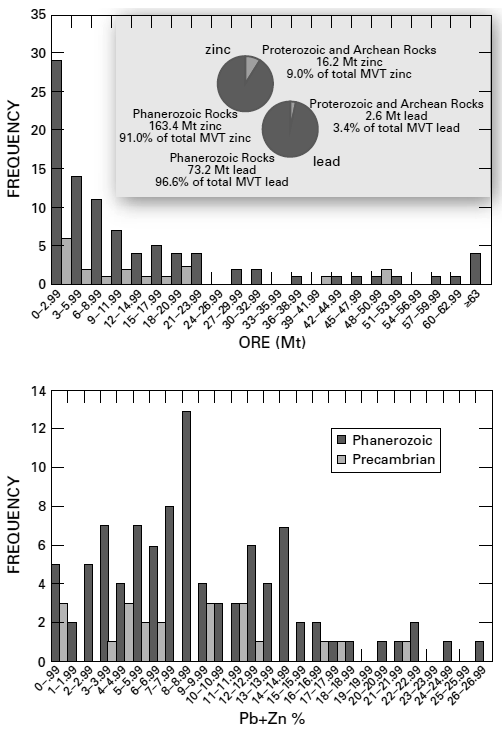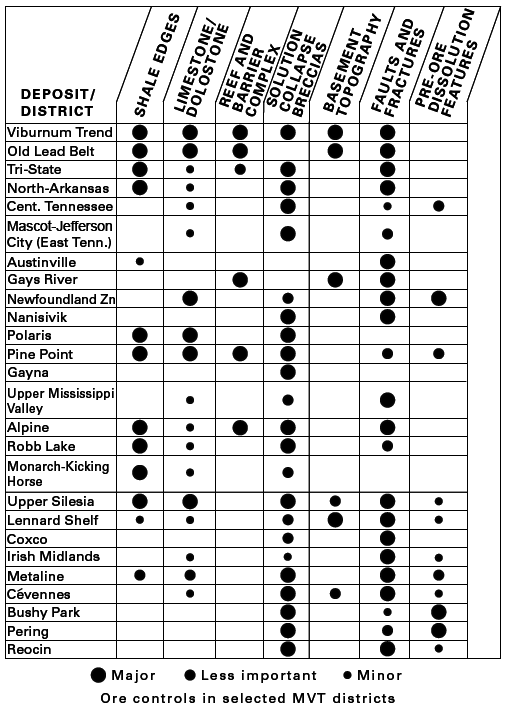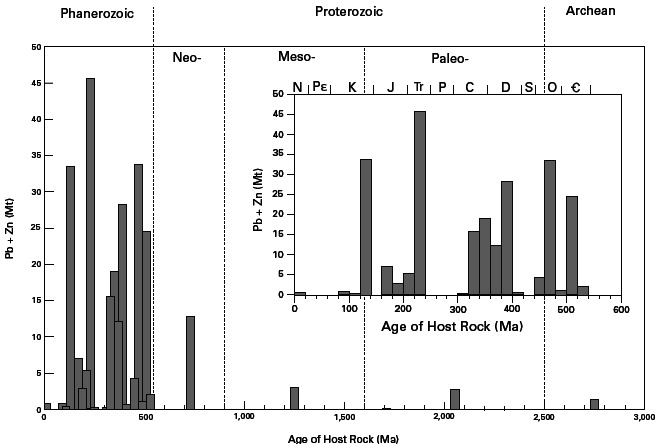Leach,D.L., Taylor,R.D., Fey,D.L., Diehl,S.F.
amd Saltus,R.W.(2010): A
Deposit Model for Mississippi Valley-Type Lead-Zinc Ores.
Scientific Investigations Report 2010.5070.A, U.S. Department
of the Interior/U.S. Geological Survey, 64p.
『ミシシッピバレー型鉛・亜鉛鉱石の鉱床モデル』
Contents
Abstract..........................................................................................................................................................1
Introduction...................................................................................................................................................1
Purpose and Scope.............................................................................................................................3
Deposit Type and Associated Commodities..............................................................................................3
Name .....................................................................................................................................................3
Synonyms..............................................................................................................................................3
Brief Description..................................................................................................................................3
Associated and Transitional Deposit Types.....................................................................................4
SEDEX ...........................................................................................................................................4
Sandstone-Lead...........................................................................................................................4
Sandstone-Hosted Lead Deposits............................................................................................4
Fracture Controlled Pb-Zn and Fluorite-Barite Deposits......................................................4
Distal Pb-Zn Skarn and Igneous Related Pb-Zn Mantos Deposits......................................4
Primary Commodities..........................................................................................................................4
Byproduct Commodities.....................................................................................................................4
Trace Constituents...............................................................................................................................5
Example Deposits................................................................................................................................5
MVT Metallogenic Provinces....................................................................................................5
MVT Districts...............................................................................................................................5
Important Deposits......................................................................................................................5
Historical Evolution of Descriptive and Genetic Knowledge and
Concepts........................................5
Regional Environment..................................................................................................................................6
Geotectonic Environment....................................................................................................................6
Temporal (Secular) Relations..............................................................................................................6
Duration of Magmatic-Hydrothermal System and/or Mineralizing
Processes..........................6
Relation to Structures.........................................................................................................................7
Relations to Igneous Rocks.................................................................................................................7
Relations to Sedimentary Rocks........................................................................................................7
Relations to Metamorphic Rocks.......................................................................................................7
Physical Description of Deposits................................................................................................................8
Dimensions in Plan View.....................................................................................................................8
Size of Hydrothermal System Relative to Extent of Economically
Mineralized Rock................8
Vertical Extent......................................................................................................................................8
Form and Shape...................................................................................................................................8
Host Rocks..........................................................................................................................................10
Structural Setting(s) and Controls...................................................................................................10
Use of Geophysics in Resource Assessment for Mississippi Valley-Type
Deposits........................12
Hypogene Ore Characteristics.................................................................................................................13
Mineralogy and Mineral Assemblages...........................................................................................13
Paragenesis........................................................................................................................................13
Zoning Patterns..................................................................................................................................13
Textures, Structures, and Grain Size...............................................................................................15
Hypogene Gangue Characteristics...........................................................................................................15
Mineralogy and Mineral Assemblages............................................................................................15
Paragenesis and Zoning Patterns.....................................................................................................16
Hydrothermal Alteration.............................................................................................................................16
Dissolution and Hydrothermal Brecciation.....................................................................................16
Dolomite and Calcite Alteration........................................................................................................16
Silicification.........................................................................................................................................16
Clay, Mica, and Feldspar Diagenesis...............................................................................................16
Supergene Ore and Gangue Characteristics...........................................................................................16
Mineral Assemblages........................................................................................................................16
Weathering/Supergene Processes...........................................................................................................17
Mineralogical Reactions to Establish Process...............................................................................17
Rates of Reactions and Factors Controlling....................................................................................17
Geochemical Characteristics....................................................................................................................17
Trace Elements and Element Associations.....................................................................................17
Zoning Patterns...................................................................................................................................19
Fluid Inclusion Thermometry and Geochemistry............................................................................19
Temperature of the Ore Fluids..................................................................................................19
Salinity of the Ore Fluids............................................................................................................19
Composition of the Ore Fluids...................................................................................................19
Metal Contents...........................................................................................................................20
Stable Isotope Geochemistry............................................................................................................20
Sulfur Isotopes...........................................................................................................................20
Carbon and Oxygen Isotopes....................................................................................................20
Radiogenic Isotope Geochemistry....................................................................................................23
Strontium Isotopes.....................................................................................................................23
Lead Isotopes.............................................................................................................................23
Petrology of Associated Igneous Rocks..........................................................................................23
Petrology of Associated Sedimentary Rocks..................................................................................24
Fracture Density and Permeability..........................................................................................24
Secondary Porosity....................................................................................................................24
Hydrothermal Cement................................................................................................................24
Organic Matter...........................................................................................................................24
Facies Transition........................................................................................................................24
Environment of Deposition.................................................................................................................24
Petrology of Associated Metamorphic Rocks................................................................................24
Theory of Deposit Formation......................................................................................................................24
Ore Deposit System Affiliation...........................................................................................................24
Sources of Metals..............................................................................................................................24
Sources of Sulfur................................................................................................................................24
Sources of Ligands Involved in Ore Component Transport..........................................................25
Sources of Fluids Involved in Ore Component Transport..............................................................25
Chemical Transport and Transfer Processes..................................................................................25
luid-Drive Mechanisms.....................................................................................................................25
Nature of Traps and Geological Controls that Trigger Ore Precipitation...................................25
Dissolution-Collapse Breccias.................................................................................................26
Faults and Fractures...................................................................................................................26
Facies Transitions......................................................................................................................26
Reef and Barrier Complexes.....................................................................................................27
Basement Topography...............................................................................................................27
Geological Assessment Guides..................................................................................................................27
Essential for Inclusion in Permissive Tracts....................................................................................27
Regional Scale Favorability................................................................................................................27
Within District (Undiscovered Deposits) Considerations.............................................................27
Geochemical and Alteration Considerations..................................................................................27
Geophysics..........................................................................................................................................28
Geoenvironmental Features and Anthropogenic Mining Effects.........................................................28
Soil and Sediment Signatures Prior to Mining................................................................................28
Secondary Minerals...........................................................................................................................28
Efflorescent Minerals.........................................................................................................................28
Drainage Signatures..........................................................................................................................29
Climate Effects on Geoenvironmental Signatures.........................................................................30
Mining Methods..................................................................................................................................30
Ore Processing Methods....................................................................................................................30
Metal Mobility from Solid-Mine Waste............................................................................................31
Volume and Footprint of Mine Waste and Tailings.........................................................................31
Smelter Signatures.............................................................................................................................32
Potential Ecosystem Impacts............................................................................................................32
Acknowledgments.......................................................................................................................................33
References....................................................................................................................................................33
Appendix.......................................................................................................................................................45
Figures
1. Map showing global distribution of Mississippi Valley-Type
lead-zinc deposits and districts...2
2. Graph showing comparison of metal content and size of Precambrian
and Phanerozoic Mississippi Valley-Type MVT deposits. Phanerozoic
MVT
deposits greatly outnumber and contain a greater quantity of metal
than Precambrian deposits...7
3. Diagram showing summary of ore controls in selected Mississippi
Valley-Type (MVT) deposits and districts...8
4. Map showing southeast Missouri mining district....................................................................9
5. Map showing the Irish Midlands mining district displaying correlation
of ores and faulting...10
6. Cross sections showing geology and mineralization in select
Mississippi Valley-Type MVT deposits. (A) Generalized section
showing piano keylike
horst/graben structure of the Toussit-Bou Beker mining district,
Morocco. (B) Cross section through the central part of the Reocin
deposit, Spain,
showing the relation of the ore lenses and the host dolostones...11
7. Cross section showing a Mississippi Valley-Type MVT deposit
in Tunisia displaying the relation between MVT mineralization
and a salt dome
environment...12
8. Graph showing summary of homogenization temperatures for sphalerite
for selected Mississippi Valley-Type deposits based on fluid inclusion
studies...19
9. Graph showing summary of fluid inclusion salinity data from
sphalerite for selected Mississippi Valley-Type deposits based
on fluid inclusion
studies...20
10. Graph showing brine compositions from fluid inclusion solutes
in sphalerite from world Mississippi Valley-Type deposits...21
11. Graph showing distribution of sulfur isotope compositions
from selected Mississippi Valley-Type deposits compared with host
rock ages...23
12. Photograph showing (A) White, efflorescent minerals formed
at the top of drying tailings, Upper Fletcher/St. Joe tailings,
Missouri, (B) Evaporative mineral crusts (arrow in A) contain
Mg-sulfate minerals, remnant etched dolomite rhombs, and sulfide
minerals consisting of etched pyrite grains from ≦20 microns and
grains of galena, sphalerite, and nickel, copper sulfides ≦5 microns.
Magnesium-sulfate minerals are poorly ordered, commonly have curved
crystal faces, and are susceptible to rapid dissolution...29
Tables
1. Summary statistics for select parameters of Mississippi Valley-Type
deposits.................4
2. Mississippi Valley-Type geophysical exploration table........................................................14
3. Mineralogical and metal associations of select Mississippi
Valley-Type
deposits/districts........................................................................................................................18
4. Important depositional models for Mississippi Valley-Type lead-zinc
deposits...............26
5. Estimates of tonnages of chat in Tri-State Superfund sites.................................................31
6. Tailings and chat distribution in the Big River mine tailings
Superfund...................................32
Appendixes
A1-A5. Graphs showing:
A1. Secular distribution of Mississippi Valley-Type deposits and
districts with paleomagnetic and/or radiometric ages of mineralization...46
A2. Secular distribution of Mississippi V
alley-Type metal and age of host rock...47
A3. Grade-tonnage for 113 Mississippi V alley-Type deposits and
10 districts...48
A4. The largest 30 Mississippi V alley-Type deposits based on
total lead and zinc content (Mt)...49
A5. Metal endowment of the 30 largest Mississippi V alley-Type
deposits in contained metal and the districts from Table A2...50
A1-A2. Tables showing:
A1. Summary of characteristics of the 30 largest Mississippi Valley-Type
deposits based on contained Pb+Zn metal...51
A2. Compilation of age and resource information for selected Mississippi
Valley-Type districts...52
Abstract
This report is a descriptive model of Mississippi Valley-Type
(MVT) lead-zinc deposits that presents their geological, mineralogical
and geochemical attributes and is part of an effort by the U.S.
Geological Survey Mineral Resources
Program to update existing models and develop new models that
will be used for an upcoming national mineral resource assessment.
This deposit modeling effort by the USGS is intended to supplement
previously published models for use in mineral-resource and mineral-environmental
assessments. Included in this report are geological, geophysical
and geochemical assessment guides to assist in mineral resource
estimation. The deposit attributes, including grade and tonnage
of the deposits described in this report are based on a new mineral
deposits data set of all known MVT deposits in the world.
Mississippi Valley-Type (MVT) lead-zinc deposits are found throughout
the world but the largest, and more intensely researched deposits
occur in North America. The ores consist mainly of sphalerite,
galena, and generally lesser amounts of iron sulfides. Silver
is commonly an important commodity, whereas Cu is generally low,
but is economically important in some deposits. Gangue minerals
may include carbonates (dolomite, siderite, ankerite, calcite),
and typically minor barite. Silicification of the host rocks (or
quartz gangue) is generally minor, but may be abundant in a few
deposits. The deposits have a broad range of relationships with
their host rocks that includes stratabound, and discordant ores;
in some deposits, stratiform and vein ore are important.
The most important characteristics of MVT ore deposits are that
they are hosted mainly by dolostone and limestone
in platform carbonate sequences and usually located at flanks
of basins, orogenic forelands, or foreland thrust belts inboard
of the clastic rock-dominated passive margin sequences. They have
no spatial or temporal relation to igneous rocks, which distinguishes
them from skarn or other intrusive rock-related Pb-Zn ores. Abundant
evidence has shown that the ore fluids were derived mainly from
evaporated seawater and were driven within platform carbonates
by large-scale tectonic events.
MVT deposits formed mainly during the Phanerozoic with more than
80 percent of the deposits hosted in Phanerozoic rocks and less
than 20 percent in Precambrian rocks. Phanerozoic-hosted MVT deposits
also account for 94 percent of total MVT ore, and 93 percent of
total MVT lead and zinc metal. Many MVT deposits formed during
Devonian to Permian time, corresponding to a series of intense
tectonic events during assimilation of Pangea. The second most
important period for MVT deposit genesis was Cretaceous to Tertiary
time when microplate assimilation affected the western margin
of North America and Africa-Eurasia.
Many subtypes or alternative classifications have been applied
to MVT deposits. These alternative classifications reflect geographic
and or specific geological features that some workers believe
set them apart as unique (for example, Appalachian-, Alpine-,
Reocin-, Irish-, Viburnum trend-types). However, we do not consider
these alternative classifications or sub-types to be sufficiently
different to warrant using them.
This report also describes the geoenvironmental characteristic
of MVT deposits. The response of MVT ores in the supergene environment
is buffered by their placement in carbonate host rocks which commonly
results in near-neutral associated drainage water. The geoenvironmental
features and anthropogenic mining effects presented in this report
illustrates this important environmental aspect of MVT deposits
which separates them from other deposit types (especially coal,
VHMS, Cu-porphyry, SEDEX, acid-sulfate polymetallic vein).

Figure 1. Global distribution of Mississippi Valley-Type lead-zinc
deposits and districts.

Figure 2. Comparison of metal content and size of Precambrian
and Phanerozoic Mississippi Valley-Type (MVT) deposits. Phanerozoic
MVT deposits greatly outnumber and contain a greater quantity
of metal than Precambrian deposits.

Figure 3. Summary of ore controls in selected Mississippi
Valley-Type (MVT) deposits and districts (from Leach and
others, 2005; modified from Leach and Sangster, 2003).

Figure 6. Geology and mineralization in select Mississippi
Valley-Type (MVT) deposits. (A) Generalized section showing
piano keylike horst/graben structure of the Toussit-Bou Beker
mining district, Morocco (from Bouabdella and others, 1996).
(B) Cross section through the central part of the Reocin deposit,
Spain, showing the relation of the ore lenses and the host dolostones
(from Leach and others, 2005; modified from Velasco and others,
2003).

Figure 7. Mississippi Valley-Type (MVT) deposit in Tunisia
displaying the relation between MVT mineralization and a salt
dome environment (modified from Leach and others, 2005).

Figure A2. Secular distribution of Missippi Valley-type metal
and age of host rock. Data for more than 100 deposits and
districts is summarized from the Neoproterozoic to present. Mesoproterozoic
deposits include Bulman and Nanisivik. Paleoproterozoic deposits
include Black Angel, Esker, and Nunngarut. Archean deposits include
Bushy Park-Pering (data from Taylor and others, 2009).

Figure A3. Grade-tonnage for 113 Mississippi Valley-Type deposits
and 10 districts. Diagonal lines represent tonnage of Pb
and Zn metal (data from Taylor and others, 2009).

Figure A4. The largest 30 Mississippi Valley-Type deposits
based on total lead and zinc content (Mt) (data from Taylor
and others, 2009).

Figure A5. Metal endowment of the 30 largest Mississippi Valley-Type
deposits in contained metal and the districts from Table
A2. Deposits are separated by host rock age of Phanerozoic or
Proterozoic (data from Taylor and others, 2009).
USGSによる『A
Deposit Model for Mississippi Valley-Type Lead-Zinc Ores』から |
ホームへ








